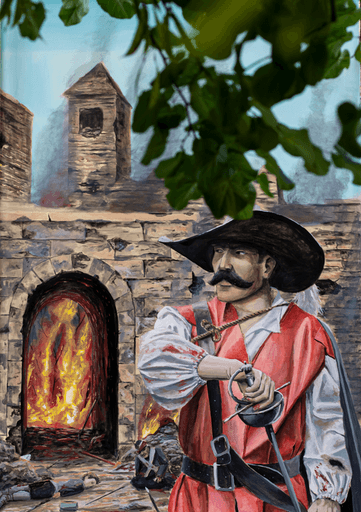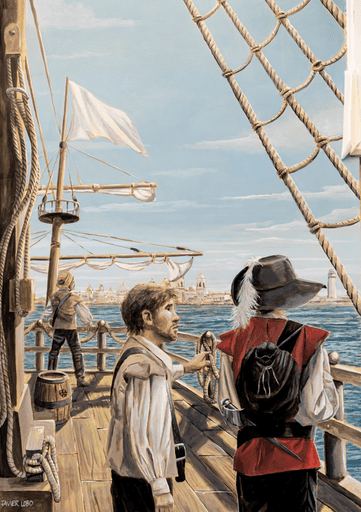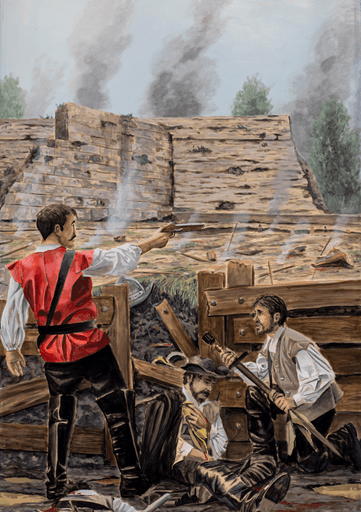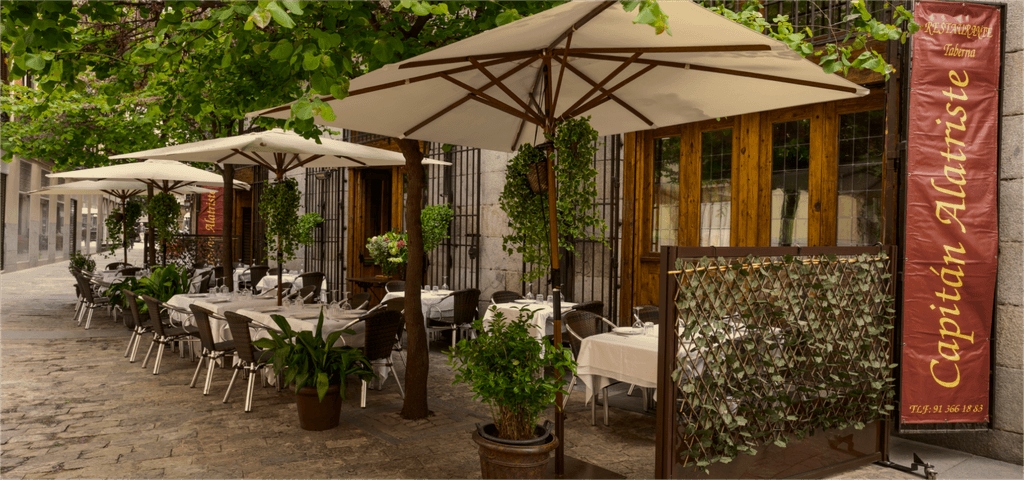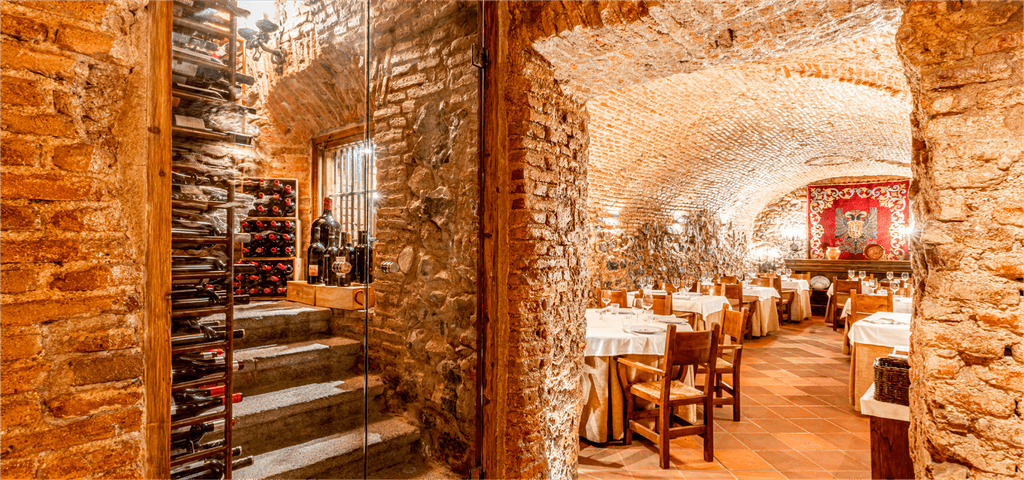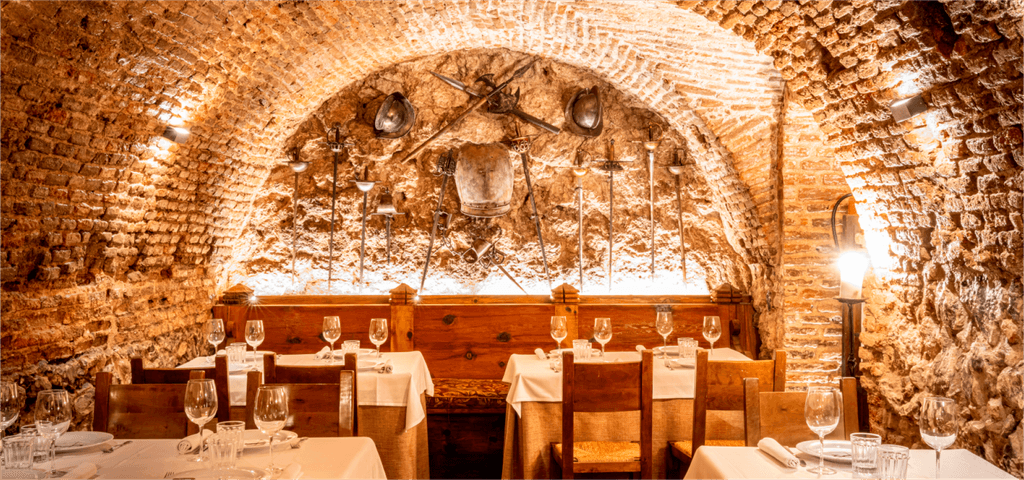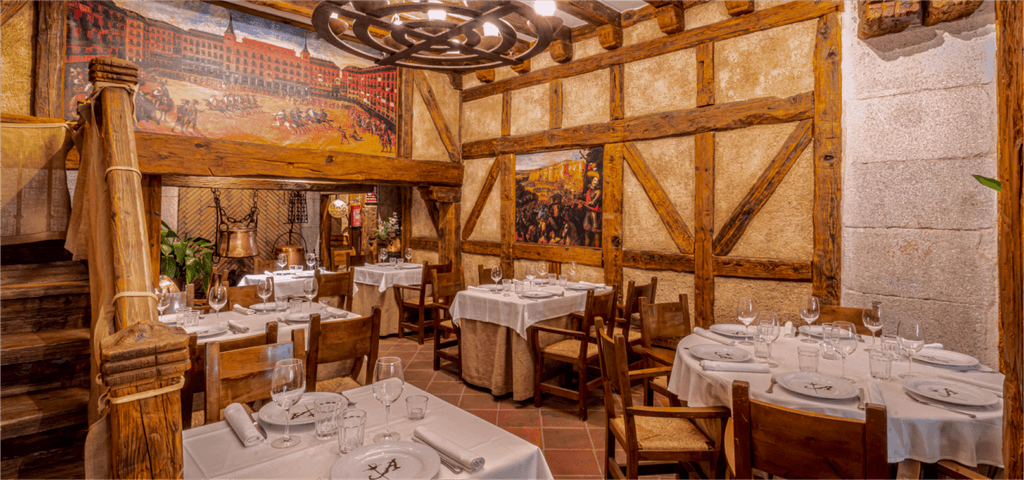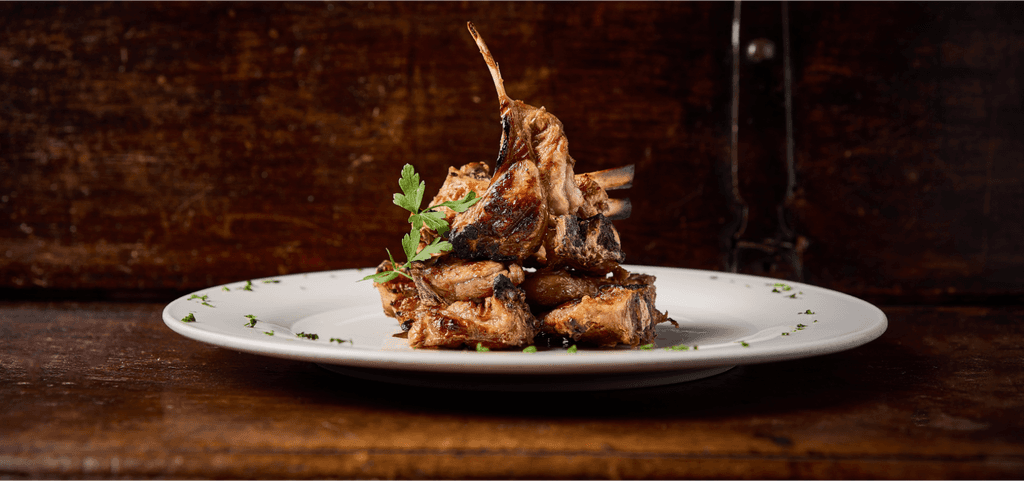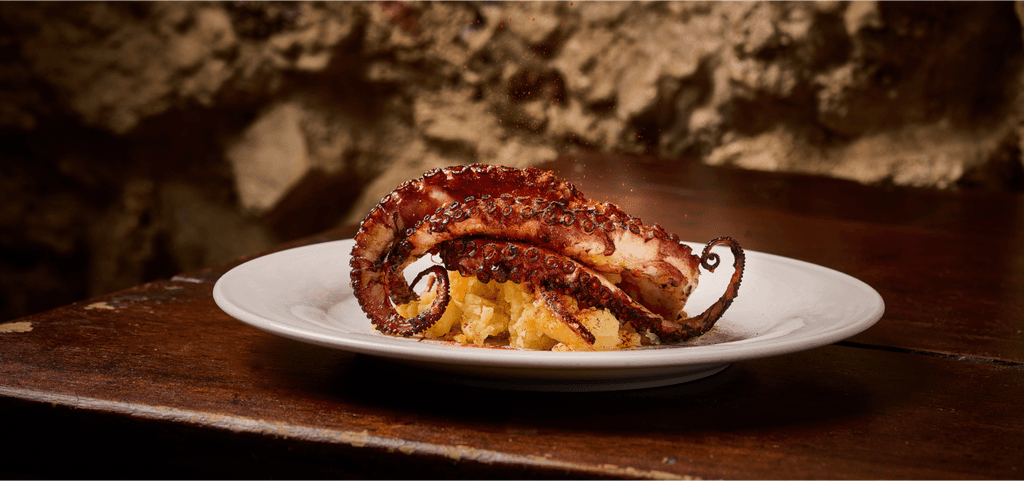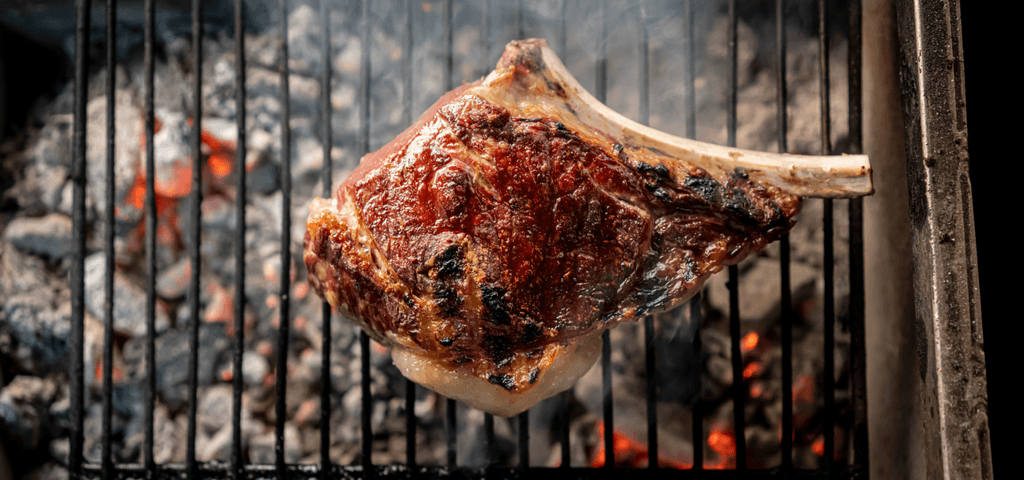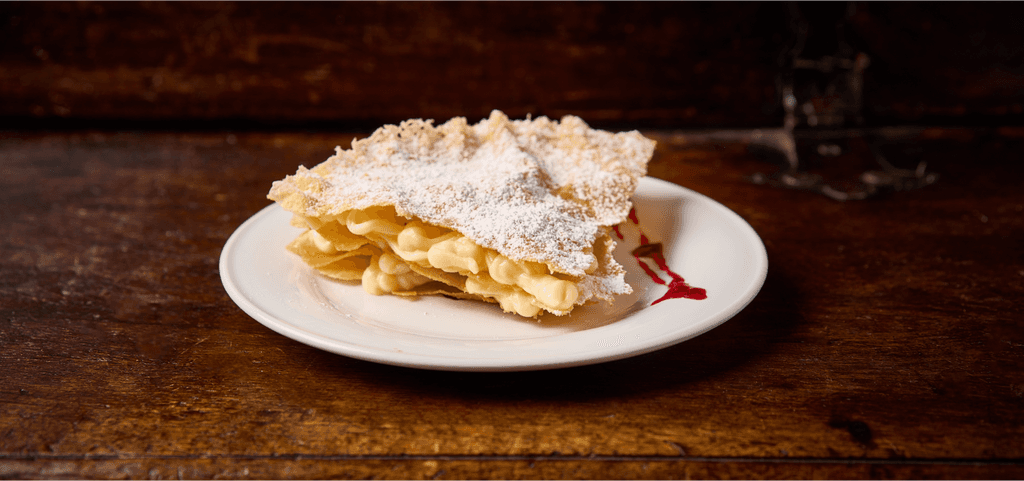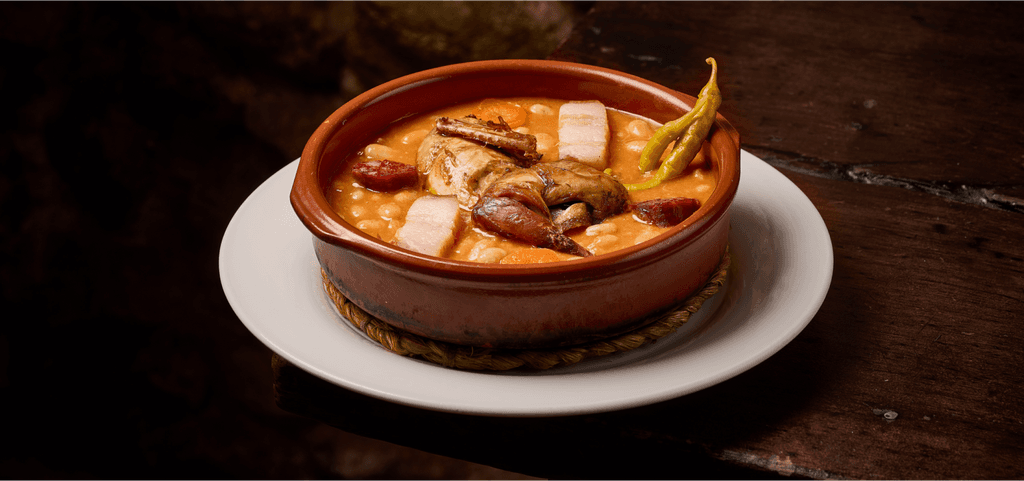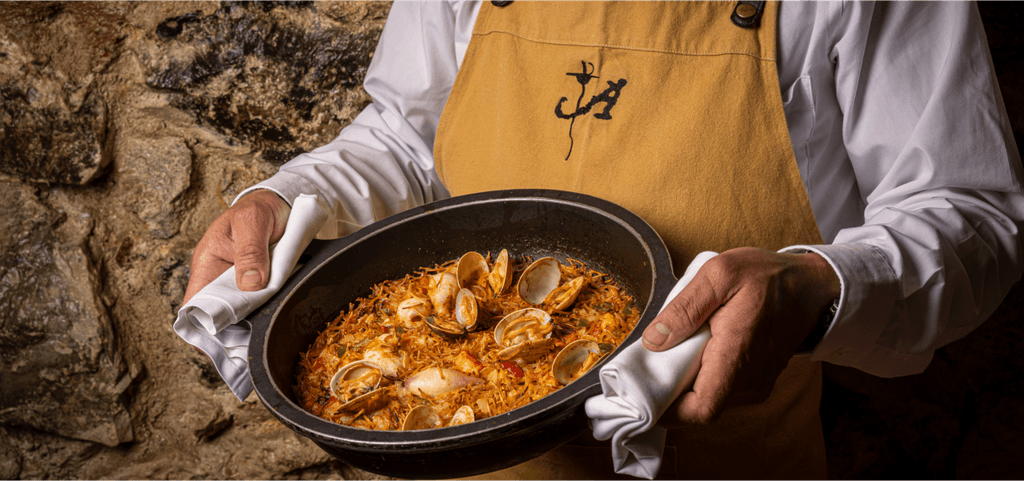Captain Alatriste’s Tavern was once called Tavern of the Turk or Tavern of Lebrijana Charity which was a famous place in Madrid at the beginning of the XVIII century. It is placed in the heart of the Austria’s neighbourhood in the intersection of San Bruno street, named received in the XVIII century known before as a Peso de la Harina or Arcabuz street, and Grafal street in 1747. The ground floor of the building maintains the old stone and brick walls. There are original intact centennial caves dated in the XVI century which were built with materials of the old Arab wall. These materials were also used to build the neighbouring houses and to fill up the old defensive moat of the city, useless already at that time. The layout of such walls and moats do not exit at present but gave origin to the current names of nearby Cava Alta and Cava Baja streets.
As detailed in different chronicles such as the well-known Papers of Second Lieutenant Balboa kept in the National Library (*), Lebrijana Charity Tavern was located between Toledo street, the Villa Inn and other traveller inns at Peso de la Harina Square in Cava Baja street. The Lebrijana Charity Tavern was a popular place in the Villa and Court frequented by soldiers, ruffians, poets and swordsmen. It was in the heart of a fascinating and dangerous city of narrow and not well lit back streets, convents, taverns, brothels and fire dives in king Felipe IV times when Madrid was still the capital of the biggest empire on earth.
Spain was arrogant and proud as evidenced on documents of that time. Life had often to be earned by the sword. That was the occupation of Diego Alatriste y Tenorio, nicknamed Captain Alatriste. He was a soldier of the “Tercio de Flandes” and an on-salary swordsman whose legendary adventures had these streets for scenario. Diego Alatriste lived in a room rented to Lebrijana Tavern together with young Iñigo Balboa, a comrade’s son who die in Flanders. Diego Alatriste met with friends and neighbours
Captain Alatriste’s Tavern was once called Tavern of the Turk or Tavern of Lebrijana Charity which was a famous place in Madrid at the beginning of the XVIII century. It is placed in the heart of the Austria’s neighbourhood in the intersection of San Bruno street, named received in the XVIII century known before as a Peso de la Harina or Arcabuz street, and Grafal street in 1747. The ground floor of the building maintains the old stone and brick walls. There are original intact centennial caves dated in the XVI century which were built with materials of the old Arab wall. These materials were also used to build the neighbouring houses and to fill up the old defensive moat of the city, useless already at that time. The layout of such walls and moats do not exit at present but gave origin to the current names of nearby Cava Alta and Cava Baja streets.
As detailed in different chronicles such as the well-known Papers of Second Lieutenant Balboa kept in the National Library (*), Lebrijana Charity Tavern was located between Toledo street, the Villa Inn and other traveller inns at Peso de la Harina Square in Cava Baja street. The Lebrijana Charity Tavern was a popular place in the Villa and Court frequented by soldiers, ruffians, poets and swordsmen. It was in the heart of a fascinating and dangerous city of narrow and not well lit back streets, convents, taverns, brothels and fire dives in king Felipe IV times when Madrid was still the capital of the biggest empire on earth.
Spain was arrogant and proud as evidenced on documents of that time. Life had often to be earned by the sword. That was the occupation of Diego Alatriste y Tenorio, nicknamed Captain Alatriste. He was a soldier of the “Tercio de Flandes” and an on-salary swordsman whose legendary adventures had these streets for scenario. Diego Alatriste lived in a room rented to Lebrijana Tavern together with young Iñigo Balboa, a comrade’s son who die in Flanders. Diego Alatriste met with friends and neighbours
such as the poet Don Francisco de Quevedo ( the greatest poet at that time and maybe of the Spanish language together with his enemy Luis de Góngora ), master Pérez ( a priest of the nearby church of the Jesuits Imperial School in Toledo street ), bachelor Calzas ( a lawyer in the nearby Provincia Square, today Santa Cruz ), former soldier Juan Vicuña ( a proprietor of a fire dive in San Miguel street ), one-eyed Fadrique ( a pharmacist in Puerta Cerrada ), and officers like lieutenant of bailiff’s Martín Saldaña (a regular of Plaza Mayor).
Those characters and the turbulent and exciting Spain to which they belonged can still be felt in these streets and places immortalized by poetry, theatre and literature. If you take a walk around the old district of the Austrias it is easy to imagine that you will see the thin and taciturn silhouette of Captain Alatriste and the shining sword of his mortal enemy, the Italian Gualterio Malatesta. Maybe you can hear the Andalusian accent of painter Velazquez on his way to the Royal Palace or listen to comedians reciting Lope de Vega or Calderon verses behind Principe or de la Cruz courtyards. These theatre performances sometimes ended in thrusts. You may find Francisco de Quevedo composing ballads about brave men and ruffians seated at one of these tables between love or sword affaires, and wine bottles. A source of special pleasure for anyone is to remove boundaries between History and fiction, combine gastronomy with fantasy, culture and memory. This place, this neighbourhood and this Madrid are good proof of it.
(*) Second lieutenant Balboa papers in Rocroi. Don Iñigo Balboa Aguirre, Captain of Felipe IV Royal Watch memoirs a hand written chronicle of 478 pages, auctioned at Claymore Auctions in London on November 21, 1951. At present in the National Library, Madrid.



